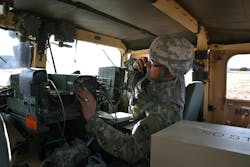Army asks industry for enabling technologies in navigation warfare (NAVWAR) to control SATCOM capabilities
ABERDEEN PROVING GROUND, Md. – U.S. Army researchers are approaching industry to identify capable navigation warfare (NAVWAR) enabling technologies to improve the way soldiers can sense their environment.
Officials of the Army Contracting Command at Aberdeen Proving Ground, Md., issued a request for information (W56KGU25R1001) last week for the Navigation Warfare (NAVWAR) Electromagnetic Support project.
Specifically, Army researchers are interested in systems that use radio frequency (RF) techniques to detect emitters; protect RF position, navigation and timing (PNT); locate emitters; and identify waveforms.
Navigation warfare, a subset of electronic warfare (EW), involves disrupting an enemy's use of Global Navigation Satellite Systems (GNSS) signals for navigation, while ensuring that friendly forces can use them effectively.
Navigation warfare can involve taking advantage of satellite navigation (SATCOM) systems; using false signals to mislead an enemy; jamming or otherwise interfering with GNSS signals; and ensuring that friendly forces can use GNSS signals without interference.
Hundreds of thousands of military systems rely on GNSS for navigation, communication, and attacking. One common NAVWAR tactic is spoofing, where an adversary sends a false signal to trick a target into making mistakes.
The Army Contracting Command issued this RFI on behalf of the Army Combat Capabilities Development Command (DEVCOM) Command, Control, Communications, Computers, Cyber, Intelligence, Surveillance and Reconnaissance (C5ISR) Center at Aberdeen Proving Ground.
Suggested enabling navigation warfare technologies should be at least ready for laboratory prototype demonstration, or as mature as ready for deployment.
The Army must compete against a complex and automated contested environment, in which warfighters must be able to sense the environments in which they are operating, researchers explain.
Researchers are interested in systems that perform one or all parts of the detect, protect, locate, characterize, and identify mission; systems that cover navigation signals at the top of the UHF band also are of interest.
Companies interested should email unclassified 20-page responses no later than 11 Nov. 2024 to [email protected] .
Email questions or concerns to the Army at [email protected] . More information is online at https://sam.gov/opp/1cf659800b4a4912b24d82c9df1bbcd0/view.
About the Author
John Keller
Editor-in-Chief
John Keller is the Editor-in-Chief, Military & Aerospace Electronics Magazine--provides extensive coverage and analysis of enabling electronics and optoelectronic technologies in military, space and commercial aviation applications. John has been a member of the Military & Aerospace Electronics staff since 1989 and chief editor since 1995.
